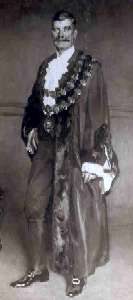Lord Mayor, Town Planner & Architect
Location: CofE*ZD*915
Born on 24 October 1858 at Hove, Sussex, England the son of Isaac Stapley a policemen and Mary née Hilton. The family had a titled baronetcy of dubious authenticity created around 1660 but had been left dormant since 1701; subsequent generations refused the title until his eldest brother Harry (d 1926) decided to claim it in 1912. After Frank’s private education and training as an architect, he went to South Africa in 1880 to practice and while there volunteered for active service in the Basuto war but was not called up; he returned to England three years later and shortly after his marriage to Eliza née Dunning migrated to Victoria.
In Melbourne he joined the leading architect William Salway (d 1903) around the same time as another up and coming architect – Harold Annear (1865-1933); Stapley later worked in the surveyor’s department of the Melbourne City Council (1887-93) before practising on his own account until a few months before his death. While his work was largely confined to industrial buildings, his most prominent design was the West Melbourne stadium noted for its lack of internal pillars to support the roof. But unlike many architects, Stapley saw the need for a visionary and co-ordinated approach towards town planning to cater for the expanding Melbourne metropolis and as president of the Royal Victorian Institute of Architects (1920-21) was able to lobby for the creation of the Metropolitan Town Planning Commission in 1922 of which he was inaugural chairman. While the final report handed down in 1929 was well received, its timing amid the onset of the depression, an unfavourable political climate and recalcitrant municipalities saw few of the recommendations implemented much to Stapley’s profound regret; the plan was largely pro-road transport that focussed on the widening of feeder roads and the construction of bridges.
On 8 November 1901, Stapley was elected to the Melbourne City Council (1901-39) replacing Cr. Arthur Tuckett and was Lord Mayor in 1917-18 defeating Sir David Hennessy (Melbourne General Cemetery) in a tight and spirited contest (“feeling ran high among the supporters of the two contestants”); the following year Stapley lost a bitter tussle with William Cabena (Melbourne General Cemetery) for re-election as mayor.
Described as “tall and handsome”, he died on 11 September 1944 survived by his second wife Edith née Simms whom he married on 3 September 1924 and was lauded for his influence over three decades as Melbourne’s chief advocate of town planning.
Source:
ADB Volume 12 1891-1939 (Smy-Z).
The Argus 10 October 1917 & 13 September 1944.
The Age 12 September 1944.
The Herald 21 October 1926 & 2 February 1935.
(Image courtesy Art and Heritage Collection, City of Melbourne)

